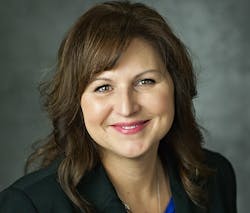ABRA’s Career Development Academy in Eagan, Minn., opened its doors in July to its first class of students, who recently graduated from the five-week program. ABRA’s latest initiative is a training course that offers guaranteed employment upon graduation at an ABRA shop and offers incentives, such as a complete tool set worth $3,000 and starting hourly wages while attending school. The academy is attempting to attract talent and close the technician shortage by making it easier for students to attend classes and spreading the word that a career in the collision industry is an attractive option for many people who wouldn’t have otherwise thought of it.
Claire Giancola-Belmares, talent outreach director, has been with the Academy for four months and helped bring in over 400 applications for the first class, which took in 10 students. Giancola-Belmares’ role is centered on building and implementing outreach strategy and spreading awareness of the program. The various techniques she uses could be implemented by any shop.
When you first came to the Career Development Academy, what was your game plan to recruit talent?
It was really baptism by fire. By the time I came aboard, things were already underway. Class dates were selected and the courses were already being formed. My priority was to learn the landscape of the academy and to find out what the barriers were for people getting into this industry. I participated in field visits and shadowed people at ABRA to learn what the job roles entailed. I spoke with people who were currently with ABRA and also people who had entered the industry and left. After speaking with people, I found out that a huge barrier was the expensive education this industry requires. Not everyone can afford to go to tech school and provide his or her own tools. Or, maybe a person could afford to attend school, but wouldn’t have enough left over to purchase the tools required after graduation. The academy addresses both of these needs by not only providing free tuition to students, but actually paying them a starting technician's hourly-wage while attending the academy. Students also receive a tool kit valued at $3,000 upon graduation.
To get the word out about the program, I worked with ABRA’s marketing team to design messaging and marketing to various audiences. I went to about 80 different organizations to share ABRA’s vision for the academy. We designed different versions of brochures, we launched the website, and we leveraged Facebook and Twitter. Thanks to all of these initiatives, we received 400 applications in a span of two to three weeks.
What did you find were the most successful ways to attract people to the academy?
The most successful technique I think was creating buzz within the industry. This program is a game changer. It brings awareness to the industry demand as a whole. After speaking with people, we heard over and over that they had been waiting for a program like this. People shared personal stories with us and we found that many started out on this career path, but either they couldn’t afford it or their parents made them attend a four-year college instead. After learning this, we knew it was important to hit on the selling points of the academy. We pointed out that people can earn a very good living. We shared testimonials from people in the trade. We also made sure that it was clear that it wasn’t just a path for people who wanted to be technicians. ABRA offers many different career paths, it doesn’t just center around body work. The academy is a great way to get a foot in the door.
How did you measure the success of the different initiatives?
For social media, our marketing team has tools to measure how long people are staying on a page or watching a video. We met frequently to discuss what was going on. During those meetings, the marketing team provided us with the analytics that helped us measure what was working and what wasn’t working. When we did our face-to-face interviews with applicants, we asked how they found out about the academy, which was helpful in determining what initiatives were reaching the most people.
Are there any strategies that you used that you might not use in the future, or are there any new strategies that you plan on trying?
I can’t say that there’s anything that we wouldn’t do again, but there are things that we’ll continue to build on. It varies from market to market. This first wave of students, we were focused on recruiting nearby talent in Minnesota and Wisconsin. Now, we’re looking toward other areas that might not have the same exposure to ABRA. We’re currently working with marketing to find the depths and reach of the company. We have regional talent acquisition managers that we’re working with. I’m also building new partnerships. The Collision Repair Education Foundation has been very helpful, and we’re working on getting the buzz from the academy out on its database.
For independent shops that are having a difficult time attracting talent, what would you suggest they do?
It’s important for shops to remember that the existing people that are working for the shop are brand advocates. Shops need to provide a career path and show that employees can grow with the company, no matter how small. It’s important to remember to focus on engagement and retention. If you have a great place to work at, your employees will share that and your shop will become a magnet. Take care of the people you have, and word will spread.

